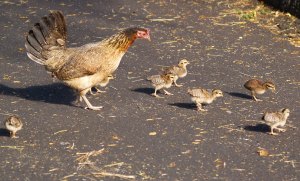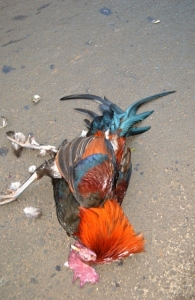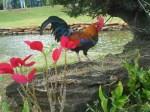Hawaii’s official State bird is the Hawaiian Goose, or Nene, but on Kauai, everyone jokes that the “official” birds of the Garden Island are feral chickens, especially the wild roosters.

Wikepedia says the “mua” or red jungle fowl were brought to Kauai by the Polynesians as a source of food, thriving on an island where they have no real predators. A clerk at the Koke’e Museum in the Waimea Canyon shared her opinion on why there are so many wild chickens on Kauai these days: “Because tourists feed them!” she responded with a laugh.
Most locals agree that wild chickens proliferated after Hurricane Iniki ripped across Kauai in 1992, destroying chicken coops and releasing domesticated hens, and well as roosters being bred for cockfighting. Now these brilliantly feathered fowl inhabit every part of this tropical paradise, crowing at all hours of the day and night to the delight or dismay of tourists and locals alike.

For the most part, Kauai’s wild chickens add to the rural environment I enjoy. But I have to admit, I’ve seen
roosters fighting over a dropped piece of pizza at the Costco food court. I’ve also watched a hungry chicken peck a toddler munching on a cracker at Hideaways Beach and I’ve seen a mother hen rush an unsuspecting tourist to protect her chicks.
Online postings demonstrate the dichotomy of the love-hate relationship visitors and locals have with Kauai’s now famous, or infamous foul, depending on your point of view. The Wild Chicken blog has readers reacting to photos of roosters, hens and baby chicks with descriptions ranging from “beautiful birds” to “god-awful rats with wings.”
So what’s good about Kauai’s wild chickens?
First of all, they eat bugs, lots of bugs, including the mean and nasty Hawaiian centipedes that can give you a painful bite similar to a hornet or wasp sting, only worse.
And let’s be honest, many tourists get a kick out of Kauai’s wild chickens and consider them part of the island’s charm, even if they suffer from crow-induced insomnia.
Shop owners will tell you that kitschy souvenirs such as chicken-themed coffee mugs, T-shirts printed with Kauai’s “official” bird, and stuffed roosters that crow, fly (pun intended) off the shelves, pumping money into the local economy.
I would guess 99.9% of tourists snap at least one photo of a feral rooster, or a wild hen with her brood of baby chicks. I’ve shot hundreds of photos of both, starting with the rooster I followed around the parking lot of the rental car company the first time I visited Kauai. –I couldn’t resist the opportunity to capture the beauty of its multi-colored iridescent feathers.
I’m sure my list of the bad things about wild chickens is incomplete, but here’s what I’ve accumulated so far:
“Cock-A-Doodle-Do” doesn’t begin to describe the cacophony wild roosters can make when they start crowing in the middle of the night. My brother, and his wife, recently visited Kauai to celebrate their 40th anniversary. The first morning following their arrival in paradise, Clark told me how the roosters woke them up around 2 a.m. shrieking what sounded to them like an ode to their home state:
“West Vir-GIN-yah!” “West Vir-GIN-yah!” “West Vir-GIN-yah!” …Ad nauseum…
“Aloha!” I responded. “Welcome to Kauai,” I added with a laugh.
Workers at the Limahuli Garden on Kauai’s north shore are trying to figure out a way to keep wild chickens from destroying their new community vegetable garden. Wire mesh fences don’t work because Kauai’s wild chickens can fly, so they’re experimenting with other humane alternatives. When my family and I volunteered to pull weeds, we noticed gardners had spread a fine mesh net on the ground to discourage fowl foraging, but it didn’t seem to be working…
Pat and John of Princeville (last name omitted by request to avoid any potential PETA protests) admit they trap and kill dozens of wild chickens every year. “Because they’re such a nuisance in the yard,” they explained. “Destroying things, digging up plants and and leaving so many unsanitary droppings,” they added.
The Kauai Humane Society used to loan residents free chicken traps, but the demand got so high, they now refer homeowners to RoosterTraps.com to buy one. KHS charges $5 for chicken pick-up, or trapped feral fowl can be dropped of at their Lihue facility to be euthanized at no charge.
The parking lot of the Koke’e Museum is nearly overrun with Kauai’s ubiquitous fowl. A posting on the Koke’e Museum’s website tries to help discourage people from feeding the wild chickens with a list of negative impacts of the growing poultry population.
–The unnaturally large flock is bad for native plants.
–Wild chickens carry diseases that kill native Hawaiian birds.
–They leave unsanitary piles of kukae moa (aka: chicken poop)
–It makes for unsafe driving when visitors brake or swerve to avoid them.

I could create an entire album of roadkill roosters to show all the wild chickens who’ve tried to cross the road in Kauai and didn’t make it, creating dangerous driving conditions and sometimes gruesome piles of bloody feathers. This photo shows one of the more sanitized shots of a dead rooster hit mid-stride on his way to another bug buffet on the opposite side of Kuhio Highway.
Joke of the day: Why do Kauai chickens cross the road? Answer: Because they own it!
Not sure if wild chicken stew belongs under the “good” or “bad” category. The few people I’ve met who admit they eat what some call “native” chicken stew, describe it as a little stringy, but tasty. Locals might share their wild chicken recipe if asked. Here’s mine: Put one wild chicken in a pot of boiling water. Add spices and a lava rock for flavor. When the rock is tender, the chicken is done. Version-2: Put one wild chicken in a pot of boiling water. Add spices and a lava rock for flavor. Simmer for several hours. Discard chicken. Eat the rock. Lol…
The ugly side of Kauai’s chickens is the popularity of cockfighting.
Cockfighting was technically banned by Hawaii’s last monarch, King Kalakaua in 1884, but it continues as a popular underground sport on Kauai and other islands.
(I had a video of an actual cockfight, shot on Molokai, posted here, but YouTube blocked it because it was too graphic.)
As recently as 2010, the Hawaii State Legislature considered a proposal that would have recognized cockfighting as a cultural activity. The resolution was approved by the House Committee on Tourism, Culture and International Affairs with the help of Kauai Representative, Roland Sagum (D-16th District). The pro-cockfighting resolution was eventually scuttled by the House Judiciary Committee where I assume the conflict with State and Federal laws was a major point of contention.
Hawaii’s cockfighting laws are already some of the most lenient in the nation: It’s not a crime to attend a cockfight, and it’s only a misdemeanor to use razor-sharp gaffs and gamble on the outcome of the often deadly and bloody battles.
Just a year before the resolution was considered, Kauai P.D. busted a large cockfight in Kapa’a where they confiscated more than a 100 roosters, 240 gaffs and $70,000 in cash. 15-roosters were already dead when police arrived and another 20 had to be euthanized by the Kauai Humane Society, due to injuries described in the Honolulu Advertiser as “horrible.”
I recently drove the same road where the cockfighting took place, and can tell you there’s a large property with multiple individualized cages where roosters are being raised. Other than breeding and cockfighting, what would these roosters be used for, eh?
The breeding farm happens to be located next door to a meditation center where I went for a deep-tissue massage. The massage was physically relaxing, but my mind remained alert because I had to listen to the competitive crowing of dozens of Kauai roosters declaring their dominance. –Er-Er-Er—Er—ERRRRR!





Speaking from experience, the young birds make wonderfully flavored fryers, though it’ll take more than one for a meal, & the older birds are delicious baked straight, or as barbeque.
Thank you for your input, Billie!
Jennifer
Aside from this chicken discussion what would u say are the best cuisine hawaii has to offer? I went once and was unable to find much I thought appealing and Im not a picky eater, I love rrgional gmfood experiences.
Brett,
Wild boar is one of the best game foods on Kauai. I suggest you try kalua pork and pork lau lau wrapped in taro leaves. Huli huli chicken is addictive too, especially at the little roadside stand in Anahola where it’s roasted over kiawe wood. I wish you happy eating on your next visit.
I liked most of my meals there, though not memorable. The one dish I came away with great fondness for was the loco moco at Tahiti Nui in Hanalei. I’m probably not spelling that right. But it was the loco moco. Definitely.
Thank you for referring your readers to my blog.
People are the disease of earth not chickens. Very very sad people don’t respect life other than other peoples because they get in trouble if they don’t. Live life being a little bit more compassionate, this planet would be a Better place. Those chickens have all the right to be alive and life their life just your stupid ass is.
Hey Cristina,
Personally, I like the wild chickens. I remember all the years my grandmother raised domesticated chickens and sold the eggs. Much easier to walk outside and get free ones.
I kill every chicken that comes into my yard. I do it to protect myself and my dog. These feral chickens carry lice, fleas, bird mites and probably other things and have diseases, like a form of tuberculosis. Don’t tell me they have a right to infect me and my dog by being alive in my yard. My dog has killed about 40 chickens this year and I’ve trapped and killed maybe 50 but that’s nothing compared to what my neighbors have done. Still they threaten to overrun this neighborhood.
The smell of these things is horrible and I find them to be ugly primitive things, not like other birds which I would rather have around than these things. Their crow drive other birds away. Not good.
However, my neighbor raises laying hens, has about 14 of them and they are completely different animals than the feral chicken. I dare you to try to take eggs from a feral hen! Bring lots of bandaids!
There is a real and distinct difference between feral animals and domesticated ones.
The feral animals do not belong in a residential neighborhood but no local or state agency will do anything about it.
That’s a shame.
WD.
That may be the stupid post I have ever read.
Totally! I love chickens and I think only depressed scum would kill them (screw u pat n john)
Is it legal to kill them in your yard? Is there a fine on Kauai. Mahalo
Dee,
Kauai has a law prohibiting cruelty to animals, so shooting or poisoning feral chickens could result in a fine, but there’s no law against trapping and removing them. The Kauai Humane Society is a good source for expert advise: ((808) 632-0610.
Personally I think wild chickens are disgusting. They are dirty a a nuisance to the island.
These birds serve as part of the beauty of Kauai.
Please don’t kill them just because.
It wasn’t their fault to be born one. Let them enjoy their lives.
People should stop feeding them wildly.
Why don’t people trap them and eat them instead of buying chicken meat from supermarkets? I’ve not heard of feral chickens problem in Asia.
In Asia Jungle fowl breed of chickens cost more to buy, than Oprington types. Any unclaimed jungle fowl roaming in the wild will soon end up as a free meal in someone’s table very soon.
Hi Casey,
I suppose it depends on how you were raised. Native Hawaiians often kill, and eat wild boar, so I’m sure there are some who eat feral chickens too, but I haven’t met many who admit it. Most locals and tourists consider wild chickens dirty and lice infested, so the thought of trapping and killing them is probably too much to handle. I attended an Earth Day event on Kauai a few years back where they demonstrated the best way to trap and cook feral chickens, boiling them until tender. I ate some, and the meat reminded me of the old laying hens my grandmother used to slaughter when they no longer produced eggs. Personally, I remember how she hung the old hens on her clothesline and slashed the inside of their throats with a sharp knife, the blood staining the grass as it drained from their beaks. That memory alone sends me to Costco to buy boneless, skinless chicken breasts after someone else has done all the dirty work… lol…
Thanks for the “pingback.” I enjoyed reading your well-written and researched blog.